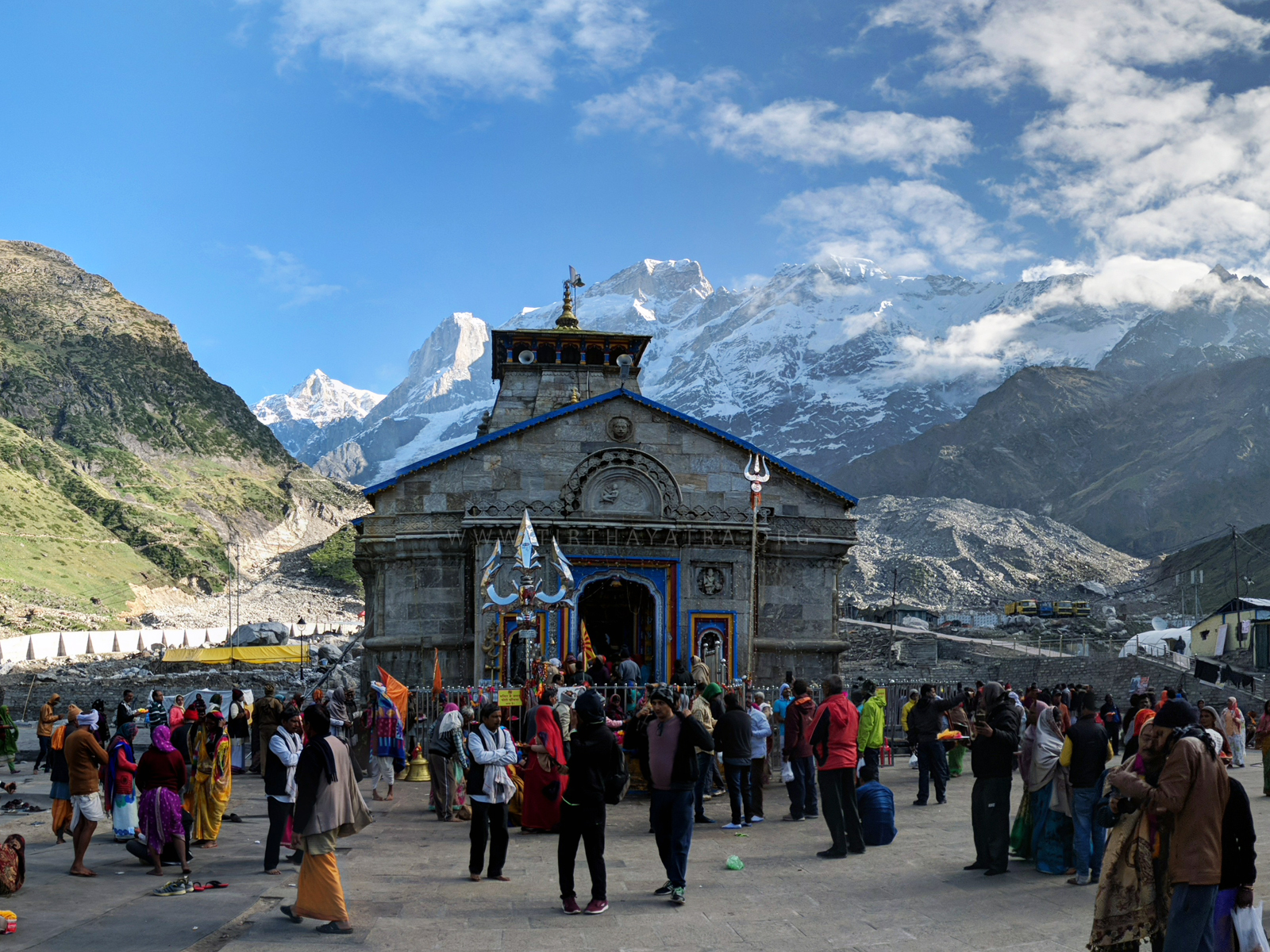
Kedarnath Temple is revered as one of the dwadasha (twelve) Jyotirlingas of Bharara Varsha. Kedarnath temple is also counted one among the four holy dhams of Uttarakhand along with Badrinath, Gangotri & Yamunotri. It is believed that Lord Narayana performed sahasranama-puja to Lord Shiva at Kedarnath.
Himalayas are geographically divided into five sections or khand, each known for a grand and celebrated temple of Lord Shiva:
1. Nepal Khand – Sri Pashupatinath Temple, Kathmandu
2. Kumanchal Khand – Sri Jagannatha (Jageshwar) Temple
3. Garhwal Khand – Sri Kedarnath Temple, Uttarakhand
4. Jalandhar Khand – Sri Baijanath Temple, Himachal Pradesh
5. Kashmir Khand – Sri Amarnath Temple, Jammu and Kashmir
The Kedarnath temple is situated in Rudraprayag district in the Indian state of Uttarakhand, at an freezing cold altitude of 11,753 feet above the sea level. The temple is situated on the foothill of Mahalaya Parvata surrounded by the Pancha Gangas, namely Kshira Ganga (Vasuki Ganga), Madhu Ganga / Madhavi Ganga, Saraswathi Ganga, Mandakini and Swarga Dari / Swargarohini.
What does Kedarnath mean?
The name Kedarnath is derived from two sanskrit words – kedar which means ‘field’ and nath means “the Lord”. The Kashi Kedar Mahatmya states that the crop of liberation grows here and hence it is called as Kedarnath. According to the chapter 17 of Krishna-janma Khanda of Brahmavaivarta Purana states the name Kedar also refers to the famous King Kedar from Satya-yuga who renunciated his kingdom and had performed tapasya in this part of the Himalaya.
As per the local folklore, Lord Shiva agreed to dwell here on the request of Nara & Narayana for the welfare of devotees. The Kedarnath temple was initially built by the Pandavas five thousand years ago. Later it was restored by Adiguru Sri Shankaracharya.
How Kedarnath Jyotirlinga manifested
As mentioned in the Chapter 19 of Kotirudra Samhita of Shiva Purana, Lord Vishnu in the form of Nara and Narayana, once performed penance in Badrikashrama. Both worshipped the shiva-linga made out of mud.
Lord Shiva was pleased by their penance and appeared in front of them and said, “I am delighted by your tapasya. Please ask me for a boon.”
Hearing Lord Shiva’s words, Nara & Narayana replied, “O Lord, if you are pleased with us, then stay here in your manifested form for the benefit of your devotees.”
Honoring their request Lord Shiva continued to stay here in the form of a linga and was known by the name Kedareshwara. Henceforth he was worshipped by the devatas and the sages.
How Kedarnath Shiva-linga manifested as per Mahabharata
After the end of Kurushetra war, sage Veda Vyasa instructed Pandavas to visit Himalayas to receive Lord Shiva’s blessings for nullifying the sin committed of killing their own kin.
Unhappy by the killing of their kinsmen by the Pandavas, Lord Shiva did not want to see them. Hence Lord Shiva took shelter at Gupt Kashi in secret. However when Pandavas came to know about this, Lord Shiva moved to Kedarnath and took the form of a bull, thus camouflaging himself in the flock of bulls grazing at Kedarnath.
Searching Lord Shiva, Pandavas reached Kedarnath and found that there are many bulls grazing in the area. In order to find out Lord Shiva in the guise of a bull, Yuddhishthira instructed Bhima to stand with legs apart and Arjuna to yoke the bulls under Bhima. One by one every bull was yoked by Arjuna, however one bull did not want to pass under Bhima. This doubted Maharaja Yudhisthira who instructed Bhima to catch the bull.
When Lord Shiva realized that he had been identified by Bhima in disguised form, Lord Shiva requested Bhumi Devi to grant him a passage for escape. While Lord Shiva was escaping from that place, Bhima quickly grabbed the tail and pulled him. Hence Lord Shiva could not pass through completely. His body from the hump till the tail remained at Kedarnath. And the face appeared at Pashupatinath.
Lord Shiva was very pleased by the determination of the Pandavas and thus appeared before them to give darshan. He also forgave their sins and instructed them to worship the self-manifested (svayambhu) Kedar Shila which was in the form of a hump of the bull. From then on this Kedar Shila is revered as the Jyotirlinga.
The bodyparts of the bull, also manifested as shiva-lingas at various locations in the Garhwal Khand of the Himalayas which are collectively known as Pancha Kedar – Kedarnath, Madmaheshwar, Tungnath, Rudranath and Kalpeshwar.
Glories of Sri Kedarnath told in different Puranas
Lord Shiva describes the unlimited glories of visiting Kedarnath to Gauri-devi. He says that anyone who describes the glories of Kedarnath, one will get freed from the sins committed. One who performs tarpana or the shraddha-puja at Kedarnath, clears the path of the ancestors towards heaven.
The Padma Purana states that when the Sun & the Jupiter enter Kumbha Rashi, at that time one who takes darshan of Lord Kedarnath and touches the shiva-linga will easily attain moksha.
The 38th chapter of the Shanti Parva of Mahabharata states that a person who thinks about Lord Kedarnath while dying, that person attains Shiva-loka.
The 83rd chapter of Vana Parva of Mahabharata states that one who takes bath in the Kedar Kunda, all the sins committed by him would be washed off. One who has darshan of Kedar on the krishna paksha chaturdashi will ascend to heaven.
The chapter 36 of Kurma Purana states that one who takes bath in the Himalaya tirtha and has darshan of Lord Kedarnath will attain Rudraloka.
In Kedarnath, there are many sacred places and sacred tirtha. One of the sacred tirthas is Udak Kund, one who drinks this water he becomes free from all the sins that he had committed, and after the death, he attains Shiva-loka.
Architecture of Kedarnath Temple
With the majestic Mahalaya Parvata as its grand backdrop, the Kedarnath temple has a fascinating and a unique architecture reflecting the traditional architure of the Garwal Mandal. The temple is constructed such scientifically that inspite of being completely under snow for more than 300 years, the temple remained intact. Even during the great flood of 2013, temple did not move even an inch thus remaining the only surviving structure of that devastation.
The Kedarnath temple is 66 feet in height topped by a wooden canopy of 10 feet and the golden kalasha. In the garbha-griha of the temple, a huge Kedar-shila is worshipped. Around the shilva-linga, is the parikrama path. The inner walls of garbha-griha are covered by nakasha work of silver. The entrance is ornate. There is a small mantapa in front of the garbha-griha followed by a pillared mantapa or the main hall; in the center of which is Nandi having darshan of Lord Kedarnath. The mantapa has Deities of Lord Shiva and Parvati, the Pancha Pandavas, Lord Krishna, Lakshmi Narayana, Nandi and Virabhadra.
The main entrance of Kedarnath Temple is ornate and made of stone. It is painted with vibrant traditional colors too. On both the sides of the door, Shringi and Bhurngi adorn as the Dwarapalakas. A huge Nandi awaits outside the main entrance looking towards Lord Kedareshwara. There is a parikrama marg outside the temple as well.
Although it is believed that the temple was originally construted by the Pandavas by the devotees, the Archaeological Survey of India states that the temple has seen at least three major renovations in the recent times:
The first uplift of the temple was done during the Gupta era as per the Guptbrahmi inscription found outside the backside the Ishan Temple. The inscription states that a temple existed here even before the 12th century AD.
The entire temple was rebuilt except the summit, in the second renovation during the 12th century AD. This is evident from few pillars and other parts of the temple and the Deities installed in the pillared hall.
The third renovation took place near the end of 18th century AD. During this, the temple summit was renovated and the front main hall was added. According to the Archaeologist, this was done by the Queen Ahilyabai Holkar.
The priests of Kedarnath Temple
The main archaka of Sri Kedarnath is called Rawal, who hails from the shringeri mutt of South India. The next Rawal is appointed from their own generation of disciples. The Rawal does not worship the shiva-linga himself, but engages his disciples to worship Lord Kedarnath. The mutt has its head office at Ukhimath. The Rawal is responsible for the worship of Pancha Kedar Temples and other eleven temples.
Darshan Timings of Kedarnath Temple
The temple timings might change as per the season and the festivals. Contact temple authorities for the exact timings.
4:00 am – bal bhog
6:00 am – arati
3:00 pm – temple closes
4:00 pm – temple opens
4:00 pm – kesariya chawal bhog
5:00 pm – shringara
7:30 pm – arati
At 5 pm the shringara puja is performed and the Kedar Shila is adorned with silver kavacha, silver cobra, trishul, damaru and the bhrungaraja flowers.
Festivals celebrated at Kedarnath Temple
Every year at Kedarnath a festival is celebrated on the occasion of Annakoot. As part of the celebrations, rice is prepared and offered to Lord Shiva. This entire shiva-linga is covered with the rice and later the same rice is distributed as prasadam. It is believed that this festival is being celebrated from the beginning of the creation. During the festival, bilvapatra and the brahma kamala are also offered to Lord Kedarnath. Apart from Kedarnath, this festival is also celebrated in the Vishwanath temple of Guptakashi and the Bholeshwar Mahadev temple of Ukhimath.
Additionally the opening and closing of the Kedarnath Temple are great events to witness. When the temple is opened for the first time after 6 months, devotees can have darshan of the akhanda jyoti which continuously lits for 6 months when the temple is closed.
At the time of closing, the Kedar Shila is covered in vibhuti and rudraksha, most of which disappears and only some part of it is found at the time of opening the temples. The remaining vibhuti and rudrakasha is distributed to the devotees as prasadam.
Best climate to visit Kedarnath
The location of the temple experiences extreme weather conditions all through the year. From October to April, the temple is closed and during this time weather conditions are very harsh making it almost impossible to visit the temple.
The best weather to visit Kedarnath is between Sep 15 and October 15. Secondly, May-June is also a an ideal time to have darshan at Kedarnath.
While traveling to Kedarnath, carry sufficient warm clothes including thermal wear as the temperature in the night can drop below 0ᵒ Celsius. It is always good to carry umbrella and shoes for protection against rainfall and snow.
How to reach Kedarnath
The best to visit Kedarnath Temple is to join the organized group tours. Tirtha Yatra conducts at least 10 tours to Kedarnath and Badrinath in the second week of May, June, September and October. For booking call us at 9844700850.
The motorable road to Kedarnath is upto Sonprayag only. From Sonprayag one can travel to Gauri Kunda by jeeps and then trek / take a helicopter / pony / doli to reach Kedarnath.
Buses ply at regular intervals between Haridwar, Rishikesh and Sonprayag. In between there are many junctions from where connectivity can be sought to Sonprayag via local jeeps / buses – Pauri, Tehri, Gupt Kashi, Uttarkashi, Rudraprayag, Srinagar, etc.
By Air
Jolly Grant Airport (Dehradun) is the nearest Airport to reach Kedarnath which is at a distance of 238 kms. Jolly Grant Airport is well connected to all major Airports of India. You may hire a local taxi from Jolly Grant Airport to reach Sonprayag.
By Rail
The nearest railway station is Rishikesh / Haridwar – both the railways stations are well connected with the rail network. From Railway Station one can hire a local taxi and reach Sonprayag.
Helicopter
If you wish to avoid trekking, you may take a helicopter ride to Kedarnath. Helipads are located between Gupt Kashi and Phata.
Trekking
From Gauri Kunda to Kedarnath the distance is approximately 19 kms through the Kedarnath wildlife sanctuary. The walk is filled with rich flora and fauna and enriched with serene nature, waterfalls and the overlooking Mahalaya Parvata.
The trekking route for the first 08 kms is gradual but after Rambada the trek gets steeper. By normal walk it takes minimum 6 – 8 hours to cover the distance. The trekking route is around 8 ft to 10 ft wide and it has an iron railing on the edge for protection.
Shelter & medical facilities available at Kedarnath
There are adequate shelters with tea and snack stalls for the pilgrims to take rest enroute the Kedarnath trek. There are medical camps too throughout the trek.
Kedarnath can accommodate maximum of 2000 pilgrims comfortably. GMVN has its dormitories and the guest house at Kedarnath. Additionally there are small bhavans to accommodate the pilgrims. There are also fiber tents to accommodate pilgrims atop. Simple food is available at many small restaurants.
References
The excerpts in this article have been taken from the following books:
Char Dham Yatra Mahatmya by Pandit Jwala Prasad Shastri
Gangotri Yamunotri Sahita, Badri-Kedar Darshan, by J P Namburi
Kedar Khand, by Hema Uniyal


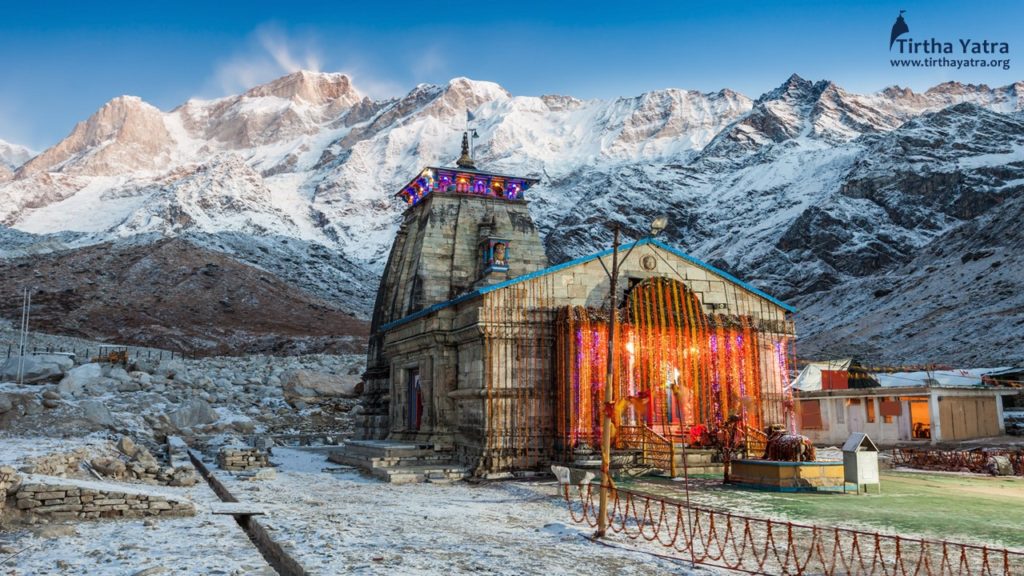
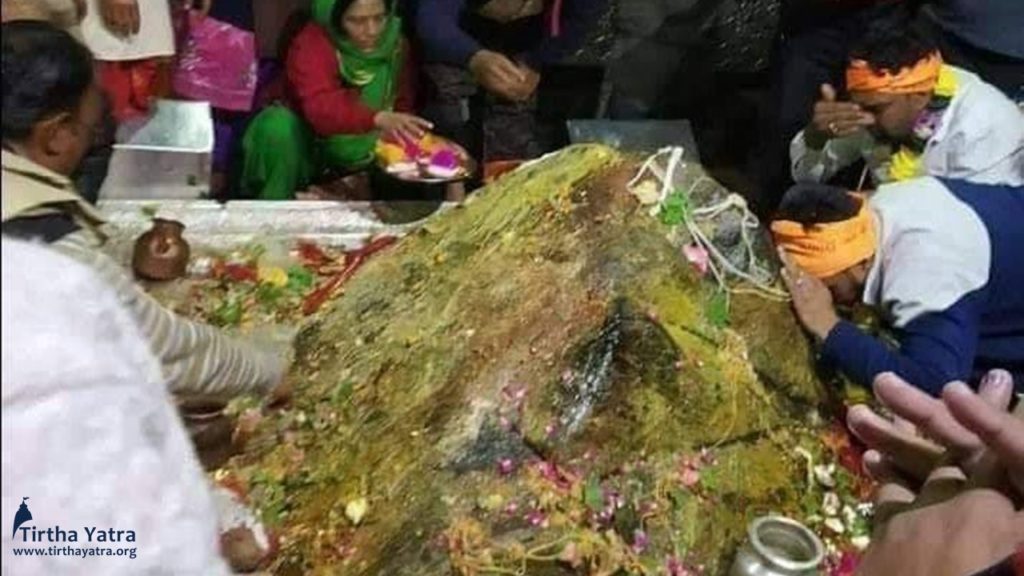
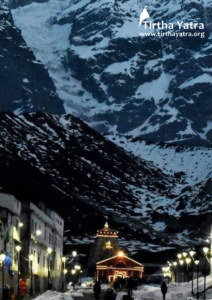
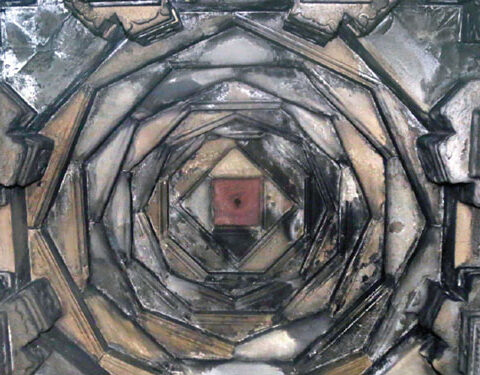
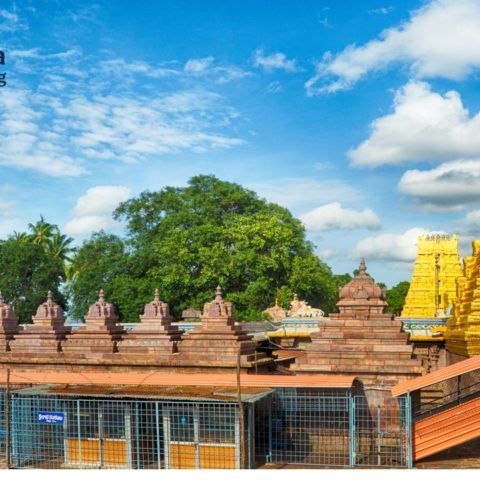
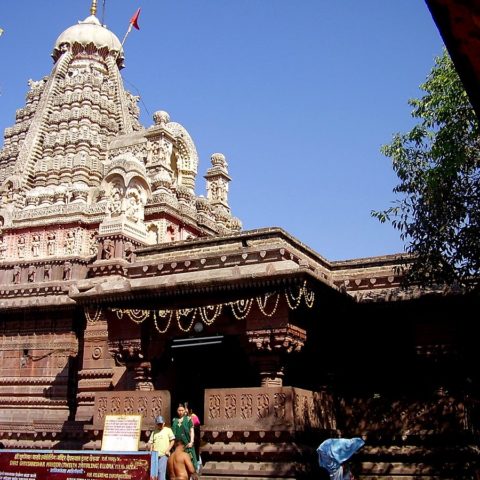










Comment On Kedarnath Temple – the Himalayan abode of Lord Shiva
Rajesh
Thank You for the useful info! I would not have gotten this otherwise!